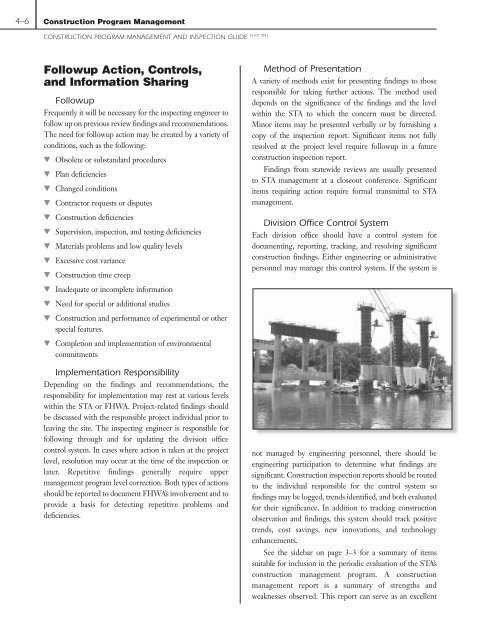Construction Program Management and Inspection Guide
Construction Program Management and Inspection Guide
Construction Program Management and Inspection Guide
You also want an ePaper? Increase the reach of your titles
YUMPU automatically turns print PDFs into web optimized ePapers that Google loves.
4–6<br />
<strong>Construction</strong> <strong>Program</strong> <strong>Management</strong><br />
CONSTRUCTION PROGRAM MANAGEMENT AND INSPECTION GUIDE (5/01/04)<br />
Followup Action, Controls,<br />
<strong>and</strong> Information Sharing<br />
Followup<br />
Frequently it will be necessary for the inspecting engineer to<br />
follow up on previous review findings <strong>and</strong> recommendations.<br />
The need for followup action may be created by a variety of<br />
conditions, such as the following:<br />
▼ Obsolete or subst<strong>and</strong>ard procedures<br />
▼ Plan deficiencies<br />
▼ Changed conditions<br />
▼ Contractor requests or disputes<br />
▼ <strong>Construction</strong> deficiencies<br />
▼ Supervision, inspection, <strong>and</strong> testing deficiencies<br />
▼ Materials problems <strong>and</strong> low quality levels<br />
▼ Excessive cost variance<br />
▼ <strong>Construction</strong> time creep<br />
▼ Inadequate or incomplete information<br />
▼ Need for special or additional studies<br />
▼ <strong>Construction</strong> <strong>and</strong> performance of experimental or other<br />
special features.<br />
▼ Completion <strong>and</strong> implementation of environmental<br />
commitments<br />
Implementation Responsibility<br />
Depending on the findings <strong>and</strong> recommendations, the<br />
responsibility for implementation may rest at various levels<br />
within the STA or FHWA. Project-related findings should<br />
be discussed with the responsible project individual prior to<br />
leaving the site. The inspecting engineer is responsible for<br />
following through <strong>and</strong> for updating the division office<br />
control system. In cases where action is taken at the project<br />
level, resolution may occur at the time of the inspection or<br />
later. Repetitive findings generally require upper<br />
management program level correction. Both types of actions<br />
should be reported to document FHWA’s involvement <strong>and</strong> to<br />
provide a basis for detecting repetitive problems <strong>and</strong><br />
deficiencies.<br />
Method of Presentation<br />
A variety of methods exist for presenting findings to those<br />
responsible for taking further actions. The method used<br />
depends on the significance of the findings <strong>and</strong> the level<br />
within the STA to which the concern must be directed.<br />
Minor items may be presented verbally or by furnishing a<br />
copy of the inspection report. Significant items not fully<br />
resolved at the project level require followup in a future<br />
construction inspection report.<br />
Findings from statewide reviews are usually presented<br />
to STA management at a closeout conference. Significant<br />
items requiring action require formal transmittal to STA<br />
management.<br />
Division Office Control System<br />
Each division office should have a control system for<br />
documenting, reporting, tracking, <strong>and</strong> resolving significant<br />
construction findings. Either engineering or administrative<br />
personnel may manage this control system. If the system is<br />
not managed by engineering personnel, there should be<br />
engineering participation to determine what findings are<br />
significant. <strong>Construction</strong> inspection reports should be routed<br />
to the individual responsible for the control system so<br />
findings may be logged, trends identified, <strong>and</strong> both evaluated<br />
for their significance. In addition to tracking construction<br />
observation <strong>and</strong> findings, this system should track positive<br />
trends, cost savings, new innovations, <strong>and</strong> technology<br />
enhancements.<br />
See the sidebar on page 3–3 for a summary of items<br />
suitable for inclusion in the periodic evaluation of the STA’s<br />
construction management program. A construction<br />
management report is a summary of strengths <strong>and</strong><br />
weaknesses observed. This report can serve as an excellent

















